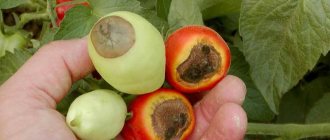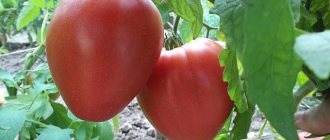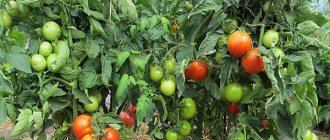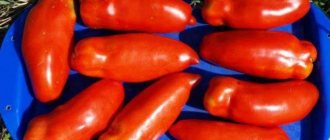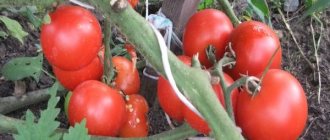| Maturing period - | 95-105 days from germination to harvest |
| Shape, weight of fruits - | round or slightly flat-round, 280-310 g |
| Determinism - | well expressed |
| Regions for cultivation - | all Russia |
| Productivity - | up to 12 kg per sq. m |
By choosing an Irma tomato, a vegetable grower can count on getting a good harvest even under unfavorable weather conditions. Tasty and heavy fruits are ideal for salads and processing.
Characteristics and description of the variety
The variety is not included in the register of breeding achievements. The user can obtain all information about the tomato from two sources:
- Directions on the seed packet from the packer.
- From the reviews of those vegetable growers who have already grown tomatoes.
There may also be two reasons for the absence of a tomato in the register:
- the variety is being tested (this will take several years);
- the variety did not pass the test for some reason.
Unfortunately, there is currently no proper control by the seed inspection. Packers pack what they see fit. The consumer is repeatedly convinced of misgrading and varietal discrepancy. In any case, the variety exists and is put up for sale. The choice is up to the consumer.
From the available information about the characteristics of the variety it follows that Irma belongs to the early-ripening, large-fruited tomatoes.
The plant is determinate. This means that the shoot ends its growth on its own. At the same time, the height of the bush does not exceed 50 cm. Irma does not require pinching, and flower clusters are laid after 1-2 leaves.
The fruits of the tomato bush are round or slightly flat-round. The skin is smooth and even. They have a classic red color and no green markings in the stalk area.
Tomatoes are dense, fleshy, elastic. The seed chambers are filled with pulp and contain a small amount of seeds.
Those who have already enjoyed the fruits of Irma claim that the tomatoes are tasty and sweet. Tomato pulp contains balanced sugars and acids, and the aftertaste is long and pleasant.
Varieties and types
click to open list
- Agatha
- Adelaide F1
- Stork F1
- Scarlet Sails
- Amulet
- Anastasia F1
- Andromeda F1
- Angelica
- Balcony miracle
- Banana red
- White filling
- Benito F1
- Betta
- Blagovest F1
- Boni-M
- Bonsai
- Nerd F1
- Brixie F1
- Boomerang F1
- Pinocchio
- Bead
- Bull's heart
- Jack F1
- Verlioka F1
- Vitador F1
- Knight
- Vladimir F1
- Volgograd early ripening 323
- Volzhsky F1
- Prodigy F1
- Garten Freunde
- Giant Novikova
- Dwarf
- Grotto
- Danna
- Summer resident
- De barao red
- De barao pink
- De barao golden
- De Barao black
- De Facto F1
- Dolphin F1
- Gina
- Dina
- Don Juan
- Donna Rosa F1
- Buddy F1
- Dubrava (Dubok)
- Evpator F1
- yellow pear
- Giraffe
- gold fish
- Ivanushka
- Intuition F1
- Iris
- Kalroma F1
- Carlos F1
- Caspar F1
- Centaur F1
- Kirzhach F1
- Cosmonaut Volkov
- Kotroma F1
- Red Arrow
- Sturdy F1
- Lafanya F1
- Lelya F1
- Leopold F1
- Lerika F1
- Lola F1
- Long Keeper
- Ray
- La-la-fa F1
- Liana
- May early
- Baby F1
- Margarita F1
- Mars F1
- Maryushka
- Master F1
- Minuet F1
- Milady F1
- Monica F1
- Moskvich
- Moscow delicacy
- Neptune F1
- NK-Sonata F1
- New from Kuban
- New product from Transnistria
- Newbie
- Novogoshary
- Nocturne-NK F1
- Gardener
- Olya F1
- Onyx
- Orange F1
- Excellent student F1
- Perseus
- Pepper-shaped
- Pilgrim 8 F1
- Pinocchio
- Portland F1
- Excellent 176
- Raissa F1
- Paradisaic delight
- Rocket
- Rhapsody-NK F1
- Pink elephant (giant)
- Roma
- Samara F1
- Santiago F1
- Northern Express F1
- Semenych F1
- Semko Sinbad F1
- Semko Soyuz F1
- Semko-100 F1
- Semko-101 F1
- Semko-2000 F1
- Semko-98 F1
- Semko-99 F1
- Siberian early ripening
- Solaris
- Soprano F1
- Soyuz – 8 F1
- Stresa F1
- Stupike (Moravian miracle)
- Typhoon F1
- Table F1
- Tambov fruitful
- Fatty F1
- meal
- Overture-NK F1
- Ulysses F1
- Unicum F1
- Hurricane F1
- Morning dew
- Favorite F1
- F1 fan
- Pharaoh F1
- Fatalist F1
- Fancy F1
- Figaro F1
- Finish
- Flagship F1
- Flamenco F1
- Funtik F1
- Persimmon
- Shuttle
- Black Iceberg F1
- Chibli F1
- Shagane F1
- Shuttle F1
- Shulga F1
- Study F1
- Junior F1
- Yamal
- Amber
- Yaroslavna F1
Low-growing, standard. Features of agricultural technology: for open ground and film tunnels. Does not require pinching or gartering. It can be grown by direct sowing into the ground. Ripening time: ultra-early, ripens in 80-85 days from the moment of emergence. Fruits weighing 60-80 g, bright red, flat-round, ribbed. Resistant to late blight and adverse weather conditions. Use: for fresh consumption and for whole-fruit canning. The ultra-earliness of the Boni-M variety ensures fast and early harvest. This means that you get early production and collect ripe fruits before the massive spread of the most harmful disease of nightshade crops - late blight. When growing the Boni-M variety in open ground, you will not need any kind of greenhouse facilities. Tomato “Boni MM”
Sowing and growing seedlings
Early tomato. Designed for growing:
- in greenhouses;
- film structures;
- open ground.
For cultivation in closed areas, earlier sowing dates are chosen. They are completely dependent on
cultivation region. You can decide on them taking into account the fact that Irma’s seedlings should be 50-60 days old at the time of planting at the fruiting site.
If the greenhouse is heated, then the last days of February are quite acceptable. For unheated film shelters, sowing is carried out in early March. When growing Irma in open ground, tomatoes are sown in the second half of March.
To ensure quick and friendly germination, the seeds are heated wetly. To do this, they are wrapped in a damp cloth and placed in a plastic bag. By maintaining the temperature at 25-27 ᵒC, the seeds will hatch in 2-3 days.
Crops are carried out as follows:
- fill the container or individual containers with soil;
- make markings 2x2 cm;
- lay out the sprouted seeds;
- sprinkle with soil mixture;
- compact;
- spray with warm water from a spray bottle;
- covered with glass or plastic film;
- sent to a warm place.
For fast and friendly shoots, Irma needs 26-28 ᵒC. After 3-5 days the shoots will be visible. The film or glass is removed.
During this period, the temperature regime is maintained as follows:
- during the day - 22-24 ᵒC;
- at night - 17-19 ᵒC.
Lower night temperatures will not allow seedlings to stretch. It is better to water in the morning with warm water.
Planting of seedlings is carried out when 2 true leaves appear. Tomatoes can be planted either in a common container with a distance between plants of 5x5 cm, or in individual cups. When picking, break off a third of the spine. This procedure will allow you to convert the taproot system into a fibrous one. If seedlings are grown in universal, professionally prepared soils, then they do not need fertilizing.
What gardeners note
Those who planted Irma actively share their impressions:
- Summer resident: “I grew the variety in open ground. The beginning of summer was cold, the fruits set poorly. The harvest was collected at the stage of milky ripeness. It took a very long time to ripen. The pulp is dense, the skin is rough. Fresh berries were scalded with boiling water and the skins were removed. Next - into the salad. The tomatoes were ideal for pickling and marinating: they did not crack. Delicious!"
- Experienced gardener: “Irma grew tomatoes under cover. The seedlings were placed in a warm bed at the end of April. First I hung double film (it was cold), and in mid-May I replaced it with lutrasil. I fed her with complex mineral water according to the scheme. I was pleased with the harvest: the first tomatoes ripened at the end of June. Then he quickly and amicably collected everything. Reviews: It’s nice to have early produce from your garden on the table; I salted the leftovers entirely. The rough skin was a little disappointing. I’ll plant it next year.”
Summer residents noted the advantages of the variety. He firmly established himself in the household plots.
Planting in the ground and caring for tomatoes
When choosing a place to plant tomatoes, you should take into account that the soil should be:
- neutral or slightly alkaline;
- highly nutritious;
- air- and water-conducted.
When choosing a site, you need to remember what grew on it last year. You can’t plant tomatoes after nightshades. The commonality of diseases will not allow obtaining a high yield.
Best predecessors:
- legumes;
- cucumbers;
- onion;
- carrot.
The seedlings are pre-hardened by taking them out into the open air for 10-15 minutes. Gradually, the time spent in air is increased. After 1.5-2 weeks, the tomatoes will be ready for planting.
The habit of the Irma bush occupies up to a meter of area. Do not thicken the plants and maintain distance:
- 50-60 cm is maintained between bushes;
- between rows 60-70 cm.
Organic fertilizers are applied to the site in the year preceding the planting of tomatoes. However, in order to obtain the harvest specified by the manufacturer, tomatoes are fed every 15-20 days.
Fertilizers begin to be applied 10 days after planting seedlings in open ground. For the first and second feeding (per 10 liters of water) use:
- ammonium nitrate - 20 g;
- potassium sulfate - 15-20 g.
For subsequent fertilizing, only potassium sulfate is used in the same dose. Tomato bushes also respond well to organic solutions. To do this, it is enough to prepare fertilizer from horse, pig or cow manure in a ratio of 1:10. If you use chicken manure, the concentration is 1:20. The dose of fertilizing is 500 ml per bush. The plant should be well watered first.
Important! You cannot increase the concentration of fertilizers, as this can lead to the accumulation of nitrates in the fruits. Feeding is carried out until mid-August.
Irma tomatoes set fruit well even under unfavorable conditions. To help the plant, it can be treated with a solution of boric acid. This should be done during the period of bud formation. The solution is prepared at the rate of 1 g of pure pharmaceutical preparation per 1 liter of water. Spraying is best done in the morning.
The characteristics of the variety indicate that the tomato does not require pinching. However, it should be taken into account that the plant cannot feed many heavy tomatoes.
Growing Irma does not require garters, but they need to be done. Clusters with heavy fruits require support, otherwise they will break the shoot. To preserve all the tomatoes, you need to start gartering from the moment the ovary forms.
Disembarkation and escapism
Before transplanting seedlings into the ground, it is necessary to harden them for 2 weeks. Take the plant outdoors
You can, in turn, open a window in the room, but do not create a draft. It should be wetted after the top layer of soil has completely dried. Before transplanting plants, it is important to choose a good shoot. It should not be excessively long, have limp leaves, or a poor root system.
Such a seedling will not take root and will not produce a harvest. It would be such a waste of time. 3 to 5 tomatoes are planted per square meter. It all depends on the capabilities of the land and the greenhouse. It is necessary to constantly mulch the soil. This way the plants will be free of weeds and also rich in organic matter. Water tomatoes at dawn in the morning or evening, when the water temperature is no more than 20 degrees.
Similar varieties
According to the characteristics and description of the variety, the Irma tomato is close to the following varieties of tomatoes:
- Summer resident;
- Yamal;
- Ivanovich F1.
Summer resident - early-ripening tomatoes that bear fruit 95-115 days after germination. They have a bright red color. The weight of one berry reaches 100 grams. The height of the bush is up to 60 cm. Tomato Yamal is an early, determinate variety. The weight of the red fruit is from 70 to 100 grams. Tomatoes do not require pinching. Ivanych F1 is a hybrid with an early ripening period (90-95 days). The red fruits with thick skin are large, weighing up to 220 grams. It has good yield and high resistance to diseases typical of tomatoes.
The best varieties of tomatoes: varieties and characteristics.
Tomato Irma is intended for cultivation in open ground conditions. The aromatic fruits of the early-ripening variety have excellent taste and are used fresh and for canning.
Advantages of the variety
Among crops intended for cultivation in open ground, the tomato variety Irma is characterized by early yield and resistance to late blight. During the growth process, a bush 60 cm high is formed.
https://www.youtube.com/watch?v=FNXGAuLkmIo
The first fruits are harvested 100 days after emergence. The formation of peduncles occurs through 2 leaves. A compact plant is planted at the rate of 6 bushes per 1 m².
When cutting a mature fruit horizontally, chambers are observed that contain few seeds. Sweet and sour fruits are used fresh as an ingredient in salads. Tomatoes are canned and canned vegetables are prepared.
The advantage of the variety is the rapid ripening of fruits.
The plant feels comfortable under temporary shelters. In cool greenhouses, the bush stretches and the fruits become small.
During the growing process, the Irma tomato requires regular application of complex fertilizers as top dressing. The rules for growing the crop provide for sowing seeds for seedlings in mid-March.
After the emergence of seedlings, the plants need to be illuminated with a lamp, extending the daylight hours to 16 hours. Tomatoes peak in the phase of having formed 2 true leaves. It is recommended to plant in open ground after the end of the spring frost period.
In the first 3 days after transplantation, plants should be covered with non-woven material. To increase crop yields, the soil is mulched with mowed, flaccid grass or dark fiber.
The plant forms a strong stem and does not require staking. But tomato bushes are prone to overload, and when the harvest is high, they fall on the beds. Mulching the soil helps preserve the harvest.
The Irma variety does not tolerate excess moisture and heat, and is sensitive to temperature changes and lack of lighting.
Those who planted the Irma tomato variety note the excellent taste of large fruits and the ability to be used as food in fresh or canned form. Reviews from summer residents indicate the plant's resistance to diseases.
“Irma planted tomatoes last season. The tomato is very easy to care for. The main thing is to sow the seedlings on time and maintain the watering regime. Do not over-water the soil, as this will reduce the yield and quality of the fruit. Fragrant fruits fall to the ground under their weight. I didn’t use a garter; I laid out a layer of grass under each bush. This is both protection from weeds and an additional opportunity to balance moisture.”
“Irma tomatoes were recommended by neighbors. I grew the seedlings myself, after pre-treating them with a solution of potassium permanganate. This made it possible to obtain friendly shoots of loops. The plant requires picking. During the growing season, no additional work on stem formation is necessary. It is stable, but is prone to deformation under the weight of tomatoes.
Experienced summer residents can boast of a successful harvest in the fall and winter, because they know exactly how to select varieties and seeds of vegetables for planting themselves.
As a rule, only the best varieties of tomatoes, cucumbers, radishes and other vegetables grow on their plot. The first type of vegetable deserves special attention, which not only has a slightly sweet taste, but also does not require painstaking cultivation.
READ MORE: Herbicide Agritox: instructions for use, spectrum of action, consumption rates
Moreover, according to the same experienced summer residents, the rapid rooting of seedlings after planting and the harvest are influenced not only by proper cultivation, but also by the correctly selected variety. This fact leads to the need to analyze the best varieties of tomatoes.
Breeders divide all varieties of tomatoes into two categories, which include:
- Determinate varieties are varieties that grow in a somewhat limited manner. So, a tomato bush grows to a certain brush and stops growing altogether. The result is a low-growing bush, but excellent for planting in a greenhouse.
- Indeterminate varieties - grow as long as the weather is favorable with its temperature indicators. They are grown in most cases in a greenhouse or in the center of a large greenhouse. These varieties are more resistant to weather conditions and therefore make up a larger proportion of the tomatoes planted.
Surprisingly, among the indeterminate varieties, the most popular and sought-after seeds are “Budenovka”. This variety is good for all its main characteristics: up to one and a half meters high, the first harvest 100 days after seed germination, the ability to grow both in a greenhouse and in open ground.
This variety also does not require any additional care and is perfect for beginner gardeners. From one bush you can harvest at least 4-5 kg, and if you create favorable climatic conditions - all 7 kg.
January and February are the right time to select and purchase tomato seeds, which we will sow in March. I have been growing tomatoes in a greenhouse and in open ground for only 6 years, but I have already managed to create my own hit parade of tomato varieties.
There are must-have varieties that I always plant every year. I like them not only for their taste and unpretentiousness, but also for the way they look on the bush. I’ll paraphrase one bearded joke: “I don’t really like tomatoes... But the process itself...”. I love going into the greenhouse and admiring the tomato plantations. And I don’t hesitate to show off my particularly spectacular huge tomatoes to my neighbors, and then post photos on the forum. It’s a shame to hide it – we all love it!
The following varieties are among the favorites also because they do not need to be fanatically cultivated and shaped. And they will always give a harvest: small, large, and a lot, depending on the variety and what I grow them for - for salads, for preparations, or, the smallest and sweetest ones, so that “like seeds, they click.” .
The “Rocket” variety is suitable for both greenhouses and open ground. The fruits are identical in shape and sweet. We love to eat them by the handful. Look good in blanks. The bush requires garter, despite the fact that the package says the opposite. This is because a lot of fruits grow, and the bush bends from the weight. Its height in open ground is about 40 cm, and in a greenhouse it can reach up to 60 cm. This is a mid-season variety; it does not need to be pinched.
Rice. 1. “Rocket” matures smoothly and is well stored in both technical and biological maturity.
READ MORE: Bindweed flower photo medicinal properties and types
I got the “Big Man” variety from a neighbor. During a tour of her greenhouse, I really liked the way it looked on the bush. The neighbor said that she has been planting it for a long time, that it is unpretentious and always sets fruit, even if the ventilation regime in the greenhouse is not followed. Of course, I took one fruit for seeding. “Zdorovyak” can grow up to 100 cm in height, so it is better to grow it in a greenhouse, although it produces large tomatoes in open ground.
Rice. 2. There is almost no need to pin the “Big Man” wrist.
Rice. 3. It ripens in batches, gradually, which is very convenient.
Among the vigorous-growing tomatoes with large fruits, I singled out the “Red Giant” variety. This amateur variety was bred by simple gardeners. Despite the fact that it grows a lot of leaves, it does not have to be pruned too often. The fruits on the lower tiers are the largest. If I had not been lazy and plucked out the inflorescences, leaving no more than 3-4 in the brush, the fruits would have been even larger. It is fleshy inside and contains few seeds.
Rice. 4. “Red Giant” in mid-July.
Rice. 5. You can take your own seeds, but the fruit must ripen on the bush and come from the second cluster from the bottom.
Rice. 6. The fruits are slightly ribbed, quite transportable, there is never a yellow-pink top from unbalanced care, as in pink-fruited varieties.
Rice. 7. Both the side of the stalk and the reverse side always have a marketable appearance.
Rice. 8. The only drawback of the “Red Giant” is that the largest fruits require a garter.
However, almost all large-fruited tomatoes require additional tying of the brushes. Except for my next favorite, Bull's Heart. I also always grow it year after year, as my grandmother advised me. “He will never let you down!” - she said, and every year I am convinced of this. Even if I took my own seeds and not factory ones, “Bull’s Heart” invariably bears fruit and does not require pinching at all, although it is vigorous.
Rice. 9. The hands grow in such a way that they do not need to be additionally secured with a garter to prevent them from falling.
Rice. 10. There is one peculiarity of the “Bull’s Heart” - a predisposition to the formation of such gnarled fruits.
Therefore, if you see a bud or flower that is too large, feel free to cut it with scissors, it will still take a long time to ripen, even though it will be large, the skin will be hard and gray, you cannot take seeds from it.
Rice. 11. But the bulk of the “Bull’s Heart” fruits are very beautiful, tasty and fleshy. By the way, this variety comes in both orange and red.
I definitely plant the listed varieties, but there are also some that I just liked, and I periodically grow them in the greenhouse, but I have not become a fan of them. Of the indeterminates, I like the raceme varieties the most. Again, this is primarily because they look beautiful on the bush. There are only three varieties, and each has a special reason to grow it.
READ MORE: Tomato Yamal 200: characteristics and description of the variety
“Intuition F1” is a mid-season hybrid, but I would classify it as a late-season hybrid. Not only does it reach harvest ripeness only by mid-August, but biological maturity also comes quite late. Some specimens of these tomatoes ripen even until the end of October. But, on the other hand, this is convenient because as a result, we have our own fresh tomatoes at home for a very long time. That's why I sow it in February.
Advantages and disadvantages
Irma has the following positive qualities:
- high productivity;
- crack resistance;
- excellent taste;
- early ripeness;
- friendly ripening and yield of the harvest;
- disease resistance.
Those who planted Irma talk about good taste, but the large, weighty fruits do not fit into the neck of the jar. The excess has to be processed into ketchup or other tomato products. The quality of such processing turns out to be very high, and the disadvantages of the variety turn into advantages.
Another drawback is that the low bush cannot hold a large fruit on its own and requires fixation. Timely garter will allow you to grow hefty tomatoes.

